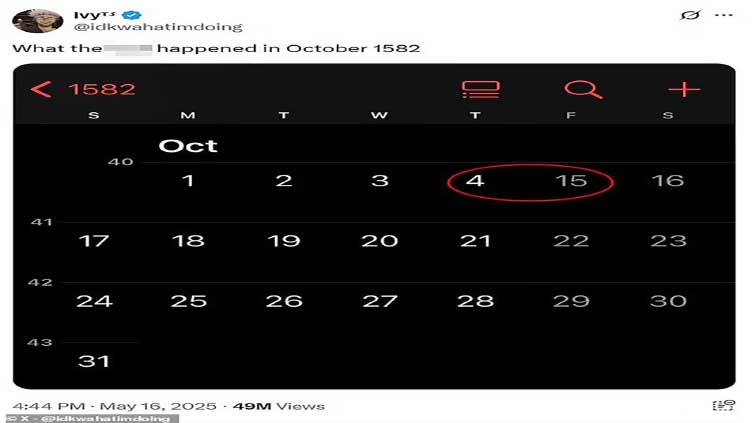Social media users baffled after discovering 10 days missing from iPhone calendar

WeirdNews
The strange omission was spotted by a sharp-eyed iPhone user
(Web Desk) - Social media users have been baffled to discover that the iPhone calendar is missing 10 days.
The strange omission was spotted by a sharp-eyed iPhone user who found that the calendar jumps from October 4 straight to October 15 in the year 1582.
In a viral post on X (formerly Twitter) viewed over 49 million times, the user asked: 'What the f*** happened in October 1582?'
Thousands of social media users flocked to the comments to share their confusion.
One commenter wrote: 'It means that all of us are 10 days older?'
Surprisingly, this isn't caused by some sort of technical glitch or mistake from Apple -and there's a simple explanation.
In reality, the reason the iPhone calendar is missing 10 days actually goes back even further - to the time of Julius Caesar.
In 45 BC, shortly before his assassination, Julius Caesar implemented what would become known as the 'Julian Calendar'.
Inspired by the Egyptian astronomers, this new calendar replaced the old lunar calendar with one based on the movements of the Earth around the sun, adding one leap day every four years.
However, although the Julian Calendar was remarkably reliable for its time, it wasn't quite perfect.
According to the Julian Calendar, the year was 365 days and 6 hours - about 11 minutes and 14 seconds longer than it actually takes for the Earth to orbit the sun.
That might not seem like a lot, but this small difference meant that the date drifted by a day every 314 years.
By the eighth century AD, Christian scholars had already begun to notice that the calendar was becoming increasingly out of sync with the actual passage of the seasons.
But the biggest concern for the Church was that these errors were making it difficult to work out the exact date of Easter.
In 325 AD, at the Council of Nicaea, the church had decreed that Easter should fall on the first Sunday following the first full moon after the vernal equinox, which was March 21 at the time.
However, as the Julian calendar slipped away, the vernal equinox was getting further and further from March 21.
To fix this discrepancy, Pope Gregory XIII signed a papal bull in February 1582, implementing a new calendar which would become known as the Gregorian Calendar.
To bring the spring equinox back to March 21, the church simply cut out the 10 days between October 4 and October 15.
October was chosen for the switch over to avoid skipping any important dates in the Church calendar.
That meant people went from celebrating the feast of St Francis of Assisi on October 4, 1582, straight to October 15 the next morning.
Since protestant and Orthodox European countries were slower to adopt the change, for hundreds of years, travelling across borders in Europe meant jumping back and forth 10 calendar days.
It wouldn't be until 1752 that the British Empire finally adopted the Gregorian Calendar, finally making it the default timekeeping system for world history.
On social media, history buffs familiar with the story were delighted to see that the iPhone calendar still reflected this 500-year-old reform.
One commenter wrote: 'They deleted 10 days like it was a bad tweet. Gregorian calendar update dropped and time got patched.'
'Imagine going to sleep on the 4th and waking up on the 15th. Rent's due. You missed your own birthday. Absolute chaos,' one commenter added.
While another joked: 'I still remember this day. Slept on October 4 and then the next morning it's October 15 already. My best sleep ever to this day.'




